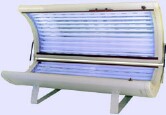
FRIDAY, March 26 (HealthDay News) — A potential ban on the use of tanning beds by people under 18 was among the recommendations Thursday by U.S. health advisers who said more measures are needed to protect consumers — especially teens — from skin-cancer risks posed by the devices.
The panel of advisers to the Food and Drug Administration also recommended that the agency add bolder warning labels to tanning beds, change how they are regulated by the FDA, and require parental consent, the Associated Press reported.
“Given the absence of any demonstrated benefit, I think it’s an obligation for us to ban artificial tanning for those under 18,” said panelist Dr. Michael Olding.
Some panel members said the scientific evidence is not clear enough to warrant a total ban.
The General and Plastic Surgery Devices Panel — part of the FDA’s Medical Devices Advisory Committee — was charged with examining the latest data on the risks of ultraviolet (UV) ray exposure from tanning beds. According to the agency, there is a growing body of evidence that shows an association between skin cancer and the use of tanning lamps.
More than 30 states already have regulations governing tanning salons, including several that require parental consent, the AP said. But the new FDA requirements would apply nationally. While the FDA isn’t required to follow the advice of its advisory panels, it typically does so.
“We are hoping the FDA will reclassify tanning beds,” Dr. Allan Halpern, vice president of the Skin Cancer Foundation, said prior to Thursday’s meeting.
Tanning beds are classified as class I medical devices, “which means these cancer-causing machines are in the same category as tongue depressors and elastic bandages and subject to few regulations and little oversight,” the group said in a news release.
The foundation would like to see the classification of tanning beds changed to a class II device. For one thing, it said, that could prevent the devices from containing mirrors, which amplify the power of UV exposure. A class II ruling would also allow the FDA to limit the levels of radiation the devices emit and make other changes to their design.
In addition, the foundation wants tanning beds to be manufactured and labeled in such a way that the public is better educated about their danger. They also want manufacturers to keep a registry monitoring the use of their products.
“UV light is a known cause of cancer,” Halpern said. “That’s recognized by the U.S. government, by the World Health Organization (WHO). And what tanning beds do is deliver UV light.”
Thursday’s meeting, which lasted five hours, featured dozens of doctors and skin cancer survivors who urged the FDA to ban indoor tanning for cosmetic uses, citing the health risks to younger Americans, the AP reported.
Dr. William James, president of the American Academy of Dermatology, said his group has seen a significant increase in skin cancer cases among women in their teens and twenties. “What was formerly considered a disease of older men is ballooning in young women, the very target audience and number one customer of the tanning industry,” he said.
Panelists also heard from representatives for the indoor tanning industry, a roughly $5 billion sector that is already being squeezed by a 10 percent tax on tanning included in the health overhaul plan that became law earlier this week, the AP reported.
The Indoor Tanning Association says the evidence linking suntan lamps to cancer is drawn from decades-old studies that were merely lumped together and reanalyzed by the WHO.
John Overstreet, executive director of the Indoor Tanning Association, said the industry is already well-regulated.
“We think the FDA does a pretty good job of regulating the industry. They have regulated the industry for 20-plus years,” Overstreet said in advance of Thursday’s meeting. “There is a lot of misinformation about the industry,” he added.
Last summer, a report from the World Health Organization’s International Agency for Research on Cancer moved tanning beds to its highest cancer risk category — “carcinogenic to humans.” Previously, the agency had classified sunlamps and tanning beds as “probably” carcinogenic, so the move put the devices a notch higher in terms of risk.
Halpern noted that the use of tanning beds by young girls and women is growing — as is their incidence of skin cancer. “There is one calculation that as many as a quarter of the melanomas in young women can be attributed directly to tanning bed use,” he said.
A bill introduced in Congress on Jan. 26, the Tanning Bed Cancer Control Act, also aims to put new restrictions on tanning bed use.
More information
There’s more on skin cancer at the American Cancer Society.

